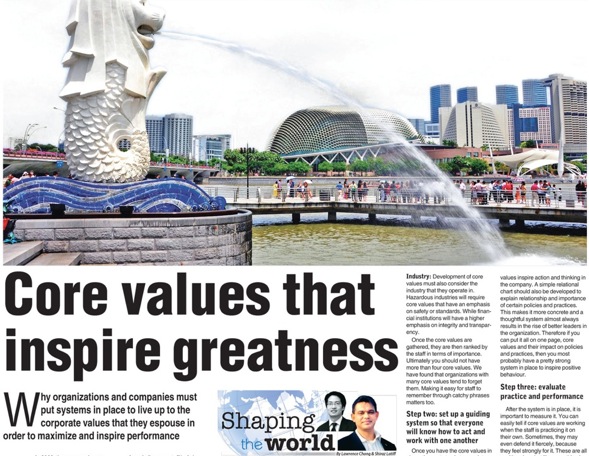In 2009, there was a vigorous debate among parliamentarians in Singapore over the national pledge and what it meant for the country. The parliamentarian who proposed the motion for debate wanted to know how the country’s policies reflect what is being said in the pledge. After days of heated argument, Mr. Lee Kuan Yew, the first prime minister of independent Singapore clarified that the pledge was meant to be an aspirational statement and that it will be unrealistic to always apply it in policy. His response ignited a furore as many Singaporeans felt that the pledge which they have said since young, is the synthesis of all that the country believe in and that nation’s policies should be guided by it.
Like Singapore, many Asian nations are at a turning point. With more empowered and knowledgeable voters, they are questioning the meaning and role of their constitutions and national values. This has led to strong electoral backlash as voters felt that their leaders are not practicing what they preach. Political leaders are caught off-guard by this behavior because they have always used national values as a broad canvas and not as precise guiding principles in how they apply policies.
In a similar way, staff in Asian companies are increasingly voting with their feet in search of better corporate cultures that put into practice what they espouse. Unfortunately, many employees tend to believe that only multi-nationals, especially western ones have corporate cultures that are values-driven. Even though this is not necessarily true, it has contributed to the loss of talent. However it is also right to say that many Asian companies can do better. Here are three reasons why:
First Reason: Having a set of core values is not enough
Most companies in Asia believe in the importance of having corporate values. They will devote resources and time to define those core values by engaging consultants and going on retreats. Sometimes these core values are placed in a prominent position in the office to serve as reminders. They are designed beautifully and is part of the interior concept for the office. Then it remains there. This is when employees get disappointed because when there is no follow-up and recognition of positive behavior, everything remains essentially the same.
Second Reason: Lack of practice leads to inefficiency and confusion
Many Asian leaders believe that having a set of corporate values is sufficient and it is like a tick on the checklist. But when policies and actions do not correspond to these corporate values, people lose their reference points. This affects the sense of ownership among staff, impairs effectiveness as there is no clarity in terms of what matters to the firm. So because of a lack of an institutional culture, one that everyone follows and practices, the culture starts to be defined by individual leaders. So staff then tend to act according to the preferences of these individuals. This increases inefficiency and confusion.
Third Reason: Lack of alignment with performance
Once you have core values that do not guide policies or corporate culture, then you end up with a lot of misalignment. This is because the company will then have many sub-cultures with their own set of values. So for one department, the actual values might be discipline and accountability, while for another it could be teamwork. The lack of a realistic understanding that ultimately, in the absence of a defined and measured culture will lead to sub-cultures, is the reason why many employees believe in the inefficacy of having corporate values.
These reasons demonstrate that it is time for Asian companies to change their approach towards core values and use it to raise the bar and maximise performance. The following are three steps on how to develop and set up a system to get the best out of this process:
Step One: Define a set of values that reflect the desired character of the organisation
Core values act like cardinal points in a compass so that you can always find your true north, which is the purpose of your company. Therefore these values should only be developed after you have defined the purpose of your company. Once you have set the purpose in place, you need to take time to consider what resonates with the organisation so as to create a set of values that the staff will embrace. We can discover possible core values in the following ways:
Stories: During the research phase, we ask management and staff to share memorable experiences. During these moments, you will notice if the episode meant something to them. In those stories, you will probably identify what values they believe is important. However if you were to ask anyone what core values matter to them in isolation, they will tend to offer generic and aspirational ones like teamwork or quality. But through stories, you get a more precise reference. And a value becomes powerful whenever you are able to associate a story with it.
Keywords: In the process of interviewing, we also take note of the unique keywords that they use. These keywords give us another set of clues in terms of identifying what matters to them in the organisation. The other important thing is how they have defined it. Once people are able to share an insight by giving a unique keyword then they are onto something valuable that will have the potential to shape the organisation.
Industry: Development of core values must also consider the industry that they operate in. Hazardous industries will require core values that have an emphasis on safety or standards while financial institutions tend to have a higher emphasis on integrity and transparency.
Once the core values are gathered, they are then ranked by the staff in terms of importance. Ultimately you should not have more than 4 core values. We have found that organisations with many core values tend to forget them. Making it easy for staff to remember through catchy phrases matter too.
Step Two: Set up a guiding system so that everyone will know how to act and work with one another
Once you have the core values in place, the next step is to appoint an internal team to review all policies and practices to see how the core values can be put into practice. It is important to have a comprehensive system that works almost like an internal ‘Global Positioning System’ so that staff will understand that you mean what you say and they will then align their behaviors accordingly. There are three core principles in setting up such a system:
Inspired practices and not more: Some companies tend to think that after the core values are determined, they need to come up with another set of rituals to reinforce this or simply organise a core values day. These are good ideas but usually people get tired of them after a while as they don’t see any practical value in them. Instead, try to review existing practices like meetings, gatherings and find ways to improve them based on the core values. For example, if a company picked ‘Learning culture’ as a core value then perhaps during the monthly meeting, someone could take 15 mins to share a brief insight into their work or suggest some improvements. When core values influence practices in a practical way, staff will appreciate and embrace them more.
Clarity of intent and not vague references: Many companies use templates for human resource and organisational development for their own use. The problem with such an approach is that they do not nurture a unique environment of creativity and collaboration. The opportunity with a new set of core values is that you can identify if your policies reflect these values and how some policies should be tweaked to get what you want. It is also good practice to insert preambles for policies to explain the intent behind them. This is great for the development of middle management. It will make it less tiresome for leaders as rank and file are clear about where the company stand on issues. So more time is spent on work rather than dealing with numerous misunderstandings over small matters.
Simplicity and not complexity: At the end of the day, it will be good to have an annual session to explain to key leaders how the core values inspire action and thinking in the company. A simple relational chart should be developed to explain relationships and the importance of certain policies and practices. This makes it more concrete, and a thoughtful system almost always results in the rise of better leaders in the organisation.
Step Three: Evaluate practice and performance
After the system is in place, it is important to measure it. You can tell if core values are working once staff start practicing it on their own. At times, they may even defend them fiercely, because they feel a strong sense of ownership. These are all positive signs but like everything in life, the process has to be moderated and adjusted yearly. At Consulus, we have a proprietary system to evaluate the will of the organisation to practice their core values and how they correspond with business performance. In the study, this is what we look out for:
AWARENESS: We test whether the rank and file in the organisation is aware of their core values and what it means for the organisation. This is the 1st level test and it shows whether the organisation appreciates the importance of core values and how well they communicate this to all staff.
BELIEF: The second level of test is belief. We would ask staff whether they believe that their colleagues or management will practice those core values. Belief is an important element. If staff know about core values but they don’t think that people will act according to them then almost all is lost. This is when you can detect the lack of will.
PRACTICE: The third and final level is practice. This is when we ask if staff have witnessed behaviors that are aligned to core values. If management or staff are unable to share stories that reflect core values then you can conclude that the company is not maximizing itself in terms of performance.
At the end of the day, all aspirational values require guardians and systems to influence and shape change. If an organisation promotes too many aspirational values without the intent to practice them, they will lose their impact. Therefore it is best to practice what you preach if you want to inspire greatness. This is at the heart of the mission for all companies; to enable communities of people to achieve their best, create sustainable value and shape a better world.
Lawrence Chong is the CEO of Consulus, a company specialising in helping Asian firms rebrand and redesign their organisations to be more innovative through business design. Consulus serve leaders in Sri Lanka in partnership with Shiraz Latiff, Chairman of Hummingbird International.




